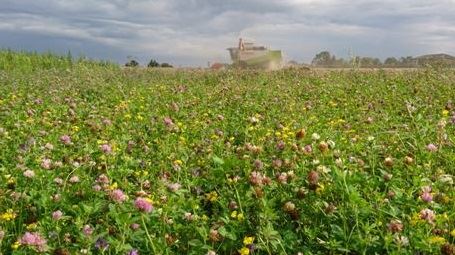Accepting EFA changes... and embracing them!
The latest Ecological Focus Area (EFA) changes announced for 2018 have caused much speculation among my colleagues and growers too. In particular, people have been very animated about the loss of crop protection products within EFAs, with some seeing it as reducing the value of EFA options on farm. Meanwhile, DEFRA termed this as a complete BAN which has only added fuel to this fire.
Whilst the changes may be significant in some areas it is worth bringing a few things into perspective and remembering that although change is ahead, there are still good opportunities to be had with EFA. Let's not 'throw the baby out with the bathwater'!
Where a grower has more than 15ha of arable land, then the 5% area allocated to EFA features is required – end of, no question. The challenge is to continue making the most of this 5% of land, even without PPPs.
Growing nitrogen fixing crops, previously a simple means of delivering EFA for many land managers, becomes more challenging without glyphosate to destroy them. Consequently, many are likely to withdraw this crop from their EFA requirements if that happens. This in turn sends growers searching for the next 'broad hectare' option to fill that gap and there are a few options worth considering.
Catch and cover crops
For many, catch and cover crops will be the obvious choice. This could be a very positive step for the farm business, bringing as it does a range of benefits for soils. It may even be the factor that gets people who have so far been 'sat on the green cover fence' involved.
All this is great but what are the options for destroying green cover crops should PPPs not be allowed within EFA option schedules in the future? Good question, and there are a number of routes:
- Fully invert/cultivate the crop. Although this won't fit with a no/min-til system. Deep-rooted crops such as tillage radish will be best avoided here.
- Choose frost sensitive species within the approved list (vetch, mustard, phacelia) so that when spring arrives there is little crop left to destroy. However, EFA rules dictate the need for a cereal to be included too, such as oats or rye.
- Graze crops down to bare ground.
- Consider using a crimper to bruise/damage the crop prior to drilling a following crop. This is technique widely used in Europe and by many organic growers in the UK. Kings is working within a research group investigating the methods and best practice within this emerging area of crop destruction.
Longer term fallow options
These can include planting nectar flower or flower rich mixturesto benefit pollinators. This can be done on a field scale, within field areas or as a field margin; whatever works best for your purposes. This is a great way of utilising less productive land to deliver pollinator habitat. A well established nectar flower mix can deliver for 3-5 years whilst a flower rich grass mix could be left for many years with minimal management once established making it very cost effective with high delivery for farm wildlife.
Benefitting a shoot
If you have sporting interests and want to benefit the shoot, as well as offering support to farmland birds, you can establish wild bird seed mixtures in autumn or spring.
With the withdrawal of PPPs the autumn establishment window is becoming more attractive, as this reduces the challenge of spring weeds such as redshank and fat hen.
Spring planting without PPPs will require more care but great results can still be achieved. My advice would be to ensure seedbeds are well prepared using a stale seedbed technique with planting delayed until late May through to mid July. Getting a crop off to a flying start is critical so that it can get away from weed and pest challenges.
Longer term cover can be used to aid sporting interests. Plant a mix containing reed canary grass and perennial chicory. Poacher Leave-it contains perennial, biennial and annual species and is a popular choice where long term cover is required. Its numerous benefits include providing wild game with sanctuary from overhead predation; delivering nesting and brood rearing habitat; offering winter holding/driving cover and providing a windbreak to conventional game cover/wild bird seed mix areas.
So rather than dwelling on what has been and gone within EFA, take the opportunity to look at what's still on offer and consider how you can adapt to develop a legislative requirement into an asset for the farm business and the wider farmed environment.
Richard Barnes
Kings sales manager
For specific advice for your business related to this blog get in touch with Kings.
As a subscriber, you’ll receive email alerts each time a new blog is published so you can always stay updated with the latest advice and insights from our experts



Comments